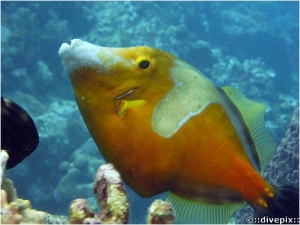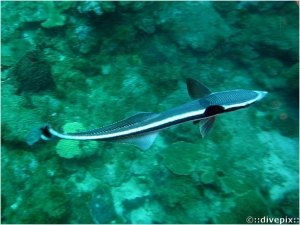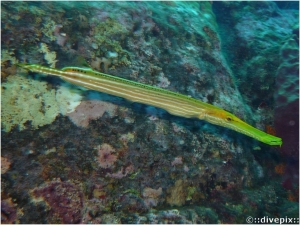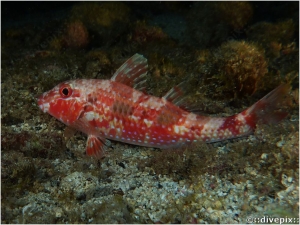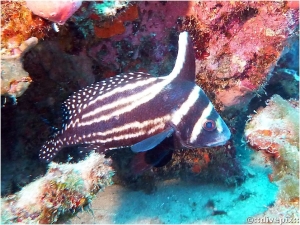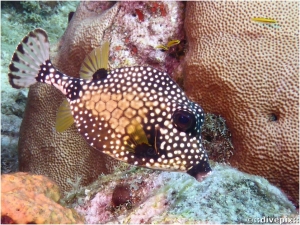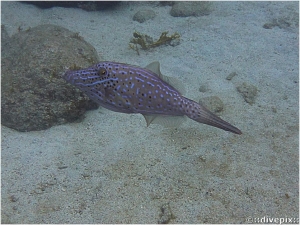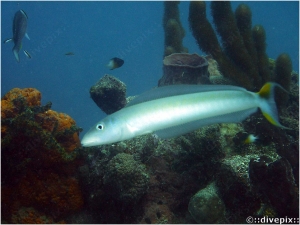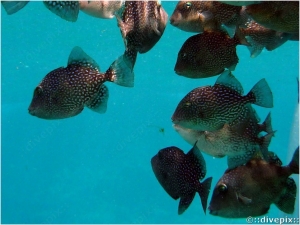




Eric H. Biass
vendredi, 14 décembre 2012 18:12
Whitespotted Filefish
| Aspect: | Typical filefish outline with heavy "keel" under a very narrow body, massive overhead spine (usually folded backwards), and fast back- positioned translucent dorsal fin mirroring anal fin. Colours, however vary dramatically depending on phase (Black when juvenile, then spotted, and finally non-spotted) as shown in these pictures. However, it can turn totally black under certain (unclear) circumstances, with fins remaining translucent yellow. Display an impressive row of frontal teeth. |
| Population: | Common. |
| Notable feature: | Always features four golden studs on each side of tail root sides, whatever the phase. |
| Environment: | Near bottom, around coral mounds, often in couples. Feeds on algae, sponges and coral. |
| Behaviour: | Easily approched, actually curious. |
Publié dans
Limes
Tags:
mercredi, 12 décembre 2012 23:09
Whitefin Sharksucker
| Aspect: | Flat-back, black body with thin white edge line running from snout to tail. White upper and lower taifin tips. White belly. |
| Population: | Seldom seen swimming around on its own. |
| Notable feature: | The most prominent, pointed part of the animal's head actually is its lower jaw! Patch of sucker blades clearly visible on top of head, down to rear part of pectoral fins. |
| Environment: | Usually stays stuck under carrier fishes like sharks and rays, but can often be seen carried by turtles as well as smaller fish like the Schoolmaster seen below. |
| Behaviour: | Unconcerned, can even want to attach to swimmers. |
Publié dans
Remoras
Tags:
mercredi, 12 décembre 2012 20:07
Trumpetfish
| Aspect: | Long cylindrical body with variable colours schemes, but usually orange to brown with white bands crossed by horizonal white lines giving a somewhat tartan-reminiscent pattern. Dorsal area usually peppered with black spots. |
| Population: | Very common. |
| Notable feature: | Mouth made to look much bigger than really is thanks to a long lateral black stain. In fact mouth is much smaller with lower hook-shaped jaw ending with a chin adorned by a kind of goatee. |
| Environment: | Often seen in a vertical position to blend in Rope Sponge and Sea Plume (q.v) coral environments. |
| Behaviour: | Can easily be approached closely. Quietly drifts vertically, sucking up a passing prey |
Publié dans
Trompettes
Tags:
mercredi, 12 décembre 2012 19:45
Spotted Goatfish
| Aspect: | Elongated generally light-coloured body that changes colour depending on activity: mottled red and white when inactive, white with four dark brown blotches along body sides when searching food. |
| Population: | Common. |
| Notable feature: | Long chin barbel resembling a goat's beard, hence vernacular name. Uses barbels to dig sand for food. |
| Environment: | Near sandy bottom. |
| Behaviour: | Easily approched. |
Publié dans
Mullidés
Tags:
mercredi, 12 décembre 2012 19:20
Spotted Drumfish
| Aspect: | Black-and-white vertical zebra pattern over head, turning longitudinal from front dorsal leading edge sweeping horizontally towards the tail fin. Rear dorsal fin and tail fin black with white dots. Juvenile has a disproportionately tall front dorsal fin, and a sharp eye will reveal a thin veil behind this, which is in fact what will eventually become the actual dotted rear dorsal fin. The Juvenile Equetus punctatus has no dots at all, not even on its tail fin. A rare frontal view of a juvenile below reveals four teeth-like bars under its black snout. |
| Population: | Common. |
| Notable feature: | Out-of-proportion front dorsal fin, particularly at Juvenile phase where it almost looks like a whip. |
| Environment: | In constant movement around rocks and small open caves. |
| Behaviour: | Must be approached quietly, but is very difficult to photograph due to its constant, brisk manoeuvres. |
Publié dans
Sciaenidés
Tags:
mercredi, 12 décembre 2012 18:50
Smooth Trunkfish
| Aspect: | More pyramidal than box, with an almost flat brownish bottom, black with white dots, although faded honecomb reticulated patch appears midbody. Probably owes its English designation to the fact that it is devoid of "horns" or spines. |
| Population: | Common. |
| Notable feature: | Lighter (pinkish) coloured thick lips surrounded by a black band |
| Environment: | Swims around rock and coral boulders. |
| Behaviour: | Can be approached, but slowly, or will swim away. |
Publié dans
Coffres
Tags:
mardi, 11 décembre 2012 19:18
Sharpnose Puffer
| Aspect: | Stocky, but small body (twice as short as Bandtail Puffer (q.v.), but with more elongated snout) . Squarish body section. Varying colours but typically brownish upper body, golden sides and lighter belly, random blue marks over the head and blue line on body close to tail. |
| Population: | Occasional, solitary. |
| Notable feature: | Prominent frog-like eyes. Like all pufferfishes, is devoid of pelvic fin. |
| Environment: | Stays close to coral sand bottom or hides in Sea Plumes (q.v.) down to 10-15 metres, feeds on tiny invertebrates. |
| Behaviour: | Very shy. |
Publié dans
Canthigasters
Tags:
lundi, 10 décembre 2012 23:40
Scrawled Filefish
| Aspect: | Elongated filefish outline with heavy belly rather than decisively marked "keel" of other Filefish. Retains overhead spine (usually folded backwards) and fast back-positioned translucent dorsal fin and mirroring anal fin. Generally pale green base-colour, but can darken. |
| Population: | Common. |
| Notable feature: | Inimitable fluo blue scribbling all over body. Paintbrush-like tail fin. |
| Environment: | Near bottom, around coral mounds. Feeds on algae, sponges and coral. |
| Behaviour: | Easily approched, but less curious than other Filefish. |
Publié dans
Limes
Tags:
lundi, 10 décembre 2012 23:22
Sand Tilefish
| Aspect: | Long, white, cylindrical streamlined white body. Body-long translucent dorsal fin, and almost as long anal fin. Oddly not extensively described in specialised printed litterature. |
| Population: | Common. |
| Notable feature: | Yellow-edged tail often features a dark area in its upper half. May sports a light blue scribbling behind the eye. |
| Environment: | Gracefully hovers above sandy seabed, feeds from small crustaceans, often seen feeding with similar food-seeking goatfishes. Builds odd-looking nesting structures by piling up dead coral branches straight onto the sandy bottom (see picture below). |
| Behaviour: | Slightly wary, can be relatively easily approached when busy looking for food in sand. |
Publié dans
Malacanthidés
Tags:
lundi, 10 décembre 2012 23:12
Rough Triggerfish
| Aspect: | Outline typical of triggerfish, with dorsal and anal fins set far back, which distinguishes it from filefish with which it is often confused. |
| Population: | Uncommon around Ilets Pigeon (see Environment), these samples having drifted from northern Guadeloupe under a patch of vegetal flotsam following a very strong storm. |
| Notable feature: | Base colour varies even within a single school from dark brown/purple to light beige, but with numerous bluish dots or short lines. Why Triggerfish? The name is owed to its peculiar mechanical defense system by which the dart it erects in lieu of forward dorsal fin is vertically locked in place by the second spine. |
| Environment: | Mangrove. |
| Behaviour: | Can easily be approached closely. |
Publié dans
Balistes
Tags:



